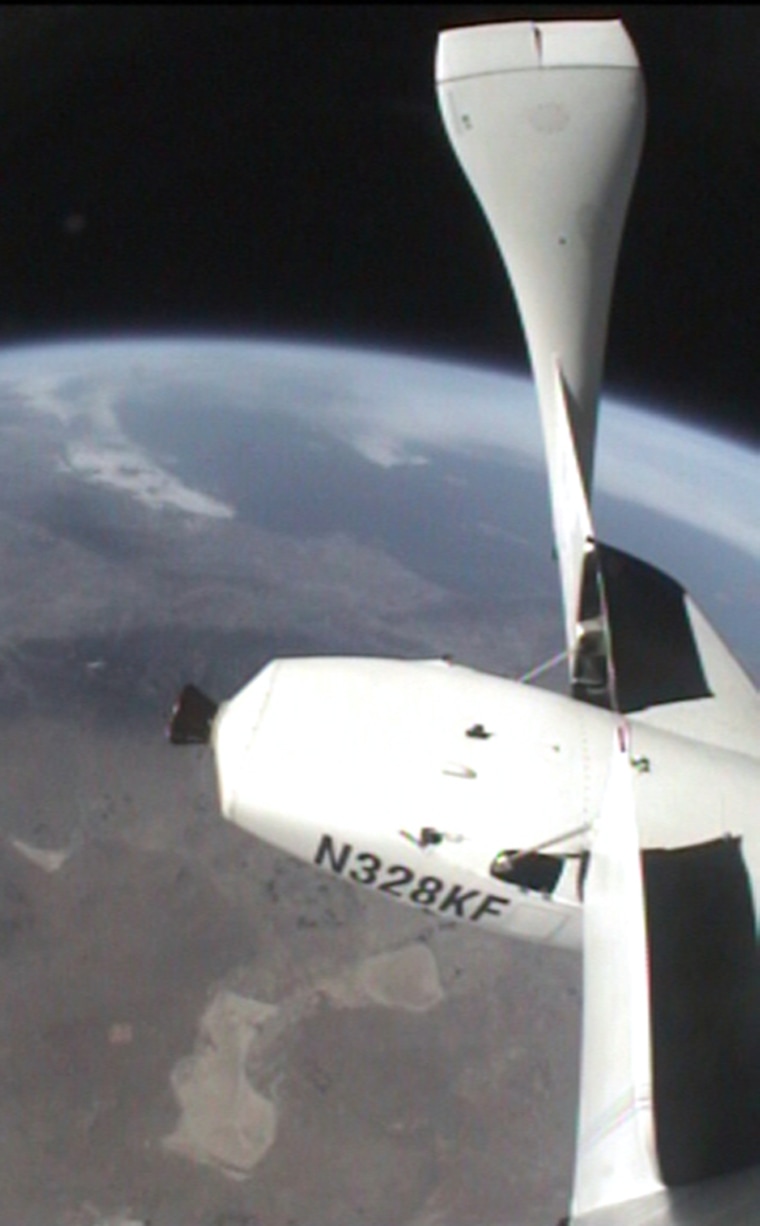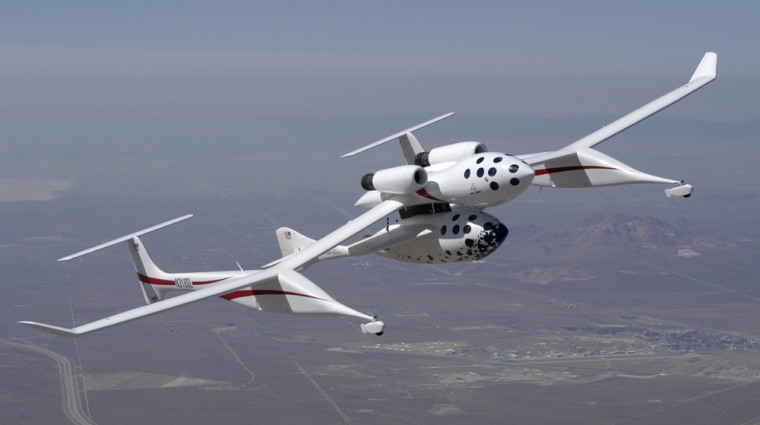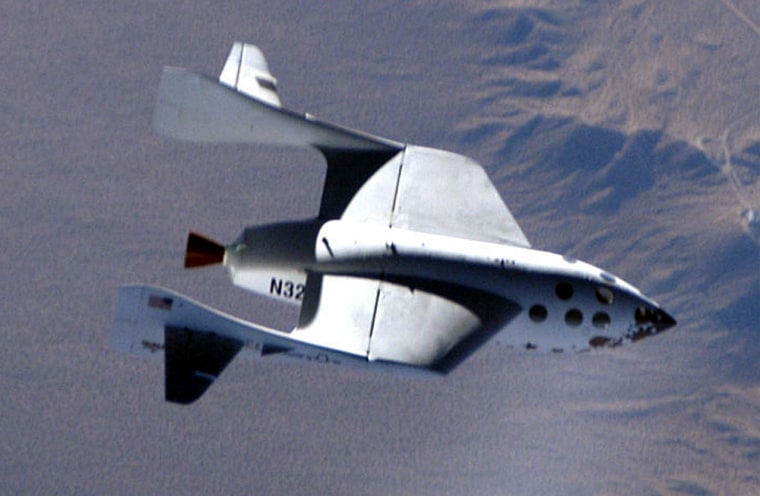SpaceShipOne's team has made a date with history for June 21, setting the first full day of summer as launch day for the first piloted spaceflight in a privately developed craft.
The announcement of the launch attempt came Wednesday morning from billionaire Paul Allen, the project's backer, and SpaceShipOne's team at Scaled Composites, headed by famed aviation designer Burt Rutan.
The aim of this suborbital flight is to reach 62 miles (100 kilometers) in altitude, which is considered the boundary of outer space. That height is also the benchmark for the $10 million Ansari X Prize competition. The X Prize Foundation's chairman, Peter Diamandis, told MSNBC.com that the June outing would serve as a "precursor" for a later prize attempt.
"This flight is a historic flight in its own right, and it’s a logical steppingstone toward any team going after the Ansari X Prize," Diamandis said. "Basically, the first step is to reach 100 kilometers altitude, and the next step is to reach that altitude with the ability to carry three individuals."
Diamandis said the June flight fit with Burt Rutan's step-by-step plan to develop the world's first fully private manned space effort — an effort that Allen praised in Wednesday's announcement.
"This flight is one of the most exciting and challenging activities taking place in the fields of aviation and aerospace today," Allen said. "Every time SpaceShipOne flies, we demonstrate that relatively modest amounts of private funding can significantly increase the boundaries of commercial space technology. Burt Rutan and his team at Scaled Composites have accomplished amazing things by conducting the first mission of this kind without any government backing."
Extensively tested
Scaled Composites' two-craft system, which features a futuristic White Knight carrier airplane as well as the SpaceShipOne rocket plane, was rolled out in April 2003 and has been tested extensively over the past year. SpaceShipOne's most recent flight on May 13, piloted by Mike Melvill, reached a height of 211,400 feet (64.4 kilometers) — higher than any private plane had gone before.

Like the earlier flights, the 100-kilometer attempt will be made from the Mojave Civilian Aerospace Test Center in California, where Scaled Composites is headquartered. The plan calls for the SpaceShipOne rocket plane to be lofted to about 50,000 feet in altitude by the White Knight carrier airplane. SpaceShipOne would then drop away and light up its hybrid rocket engine for about 80 seconds, reaching a top speed of Mach 3, or three times the speed of sound.
As the craft crests the 100-kilometer mark, the pilot would see the blackness of space and the curvature of the earth, and feel weightlessness for about three minutes.
During atmospheric re-entry, the pilot would configure SpaceShipOne's wings into a high-drag mode to slow the craft down, then set the wings back into their conventional mode to glide to a landing back at the Mojave Airport.
Astronaut wings
The pilot — who is yet to be named from Scaled Composites' pool of four — would become the first person to earn astronaut wings in a vehicle not sponsored by a government, and the first private civilian to fly a spaceship out of the atmosphere, Rutan noted.

"Since Yuri Gagarin and Al Shepard's epic flights in 1961, all space missions have been flown only under large, expensive government efforts," Rutan said in the announcement. "By contrast, our program involves a few dedicated individuals who are focused entirely on making spaceflight affordable. Without the entrepreneur approach, space access would continue to be out of reach for ordinary citizens. The SpaceShipOne flights will change all that and encourage others to usher in a new, low-cost era in space travel."
Advance details of the SpaceShipOne test effort are usually closely held. Wednesday's alert marked the first time that a flight was announced in advance. The event will be open to public viewing, Scaled Composites said, with the White Knight scheduled to taxi out for takeoff at 6:30 a.m. PT (9:30 a.m. ET) June 21. The entire flight would last roughly 25 minutes, Scaled said on a "Frequently Asked Questions" Web page.
Brian Feeney of the Canadian-based da Vinci Project, one of Rutan's competitors for the Ansari X Prize, speculated that more than 250,000 people might turn out to witness the Mojave launch.
Prize flight yet to come
SpaceShipOne is considered the favorite to win the Ansari X Prize, but the June flight will not be part of an X Prize attempt. To win the prize, notice of an attempt must be given 60 days in advance, and the 100-kilometer flight must be done twice in a two-week period, with a pilot and enough ballast to represent the weight of two passengers. June's flight will be a solo outing, without the extra ballast.
Twenty-five other teams are vying for the $10 million prize, which is modeled after the $25,000 Orteig Prize for trans-Atlantic flight that was won by aviator Charles Lindbergh in 1927.
Diamandis, the chairman and co-founder of the St. Louis-based X Prize Foundation, said attempts to win the Ansari X Prize would "likely" come this summer. Feeney told MSNBC.com that the da Vinci Project was preparing for a summer launch of its Wildfire rocket from a balloon over Saskatchewan.
"We clearly have other teams inching up behind Burt, and I still think it’s a race," Diamandis said.
Diamandis said this month's flight would lead toward an age when private spaceships could take paying passengers on suborbital space jaunts. Even now, SpaceShipOne is equipped with two passenger seats as well as the pilot's station.
"Our objective is not just to create a vehicle that can carry one test pilot — we've had that for decades — but to create a new class of vehicles that can carry the public to space," he said.
Burt Rutan, who turns 61 on June 17, is known for his innovative aircraft designs, including the Voyager, which in 1986 became the first aircraft to fly around the world nonstop without refueling. Last year, he drew parallels to the early days of aviation in the 1900s and said he hoped the SpaceShipOne effort would "mark the beginning of a renaissance for manned spaceflight."
, 51, who is best-known as a co-founder of Microsoft, has not revealed how much he spent on the SpaceShipOne effort, other than to say it has amounted to "tens of millions" of dollars. (MSNBC is a Microsoft-NBC joint venture.) Observers speculate that the expense is in the $25 million range — a significant figure, but far less than the estimated $500 million cost of a space shuttle mission.
Allen's portfolio extends to entertainment (including DreamWorks and Oxygen Media) as well as sports (including the Seattle Seahawks and the Portland Trail Blazers). His film production company, Vulcan Productions, is working with the Discovery Channel on a TV documentary titled "Rutan's Race for Space."
In Wednesday's statement, Rutan paid tribute to Allen: "To succeed takes more than the work of designers and builders. The vision, the will, the commitment and the courage to direct the program is the most difficult hurdle. We are very fortunate to have the financial support and the confidence of a visionary like Paul Allen to make this effort possible."
